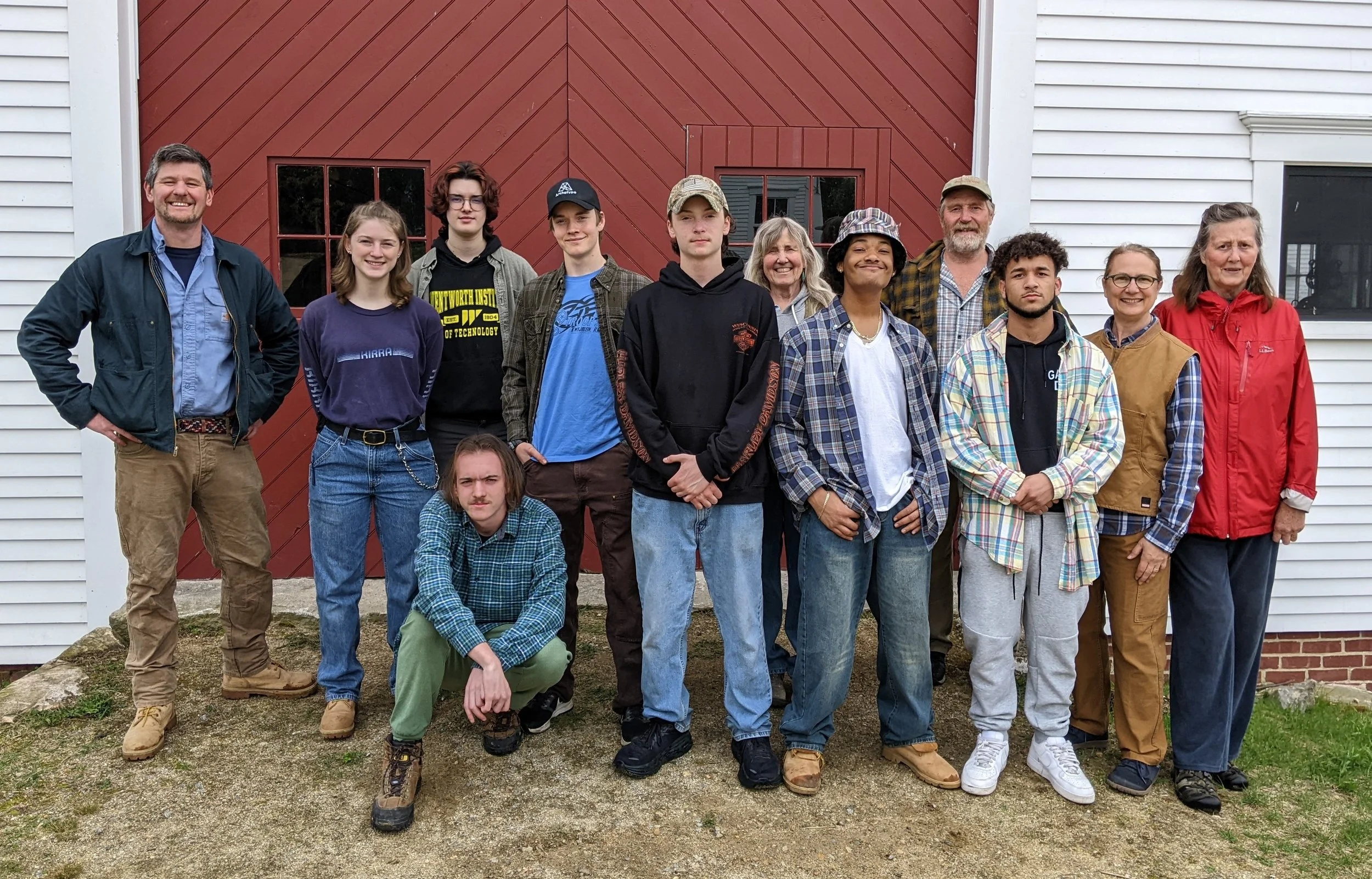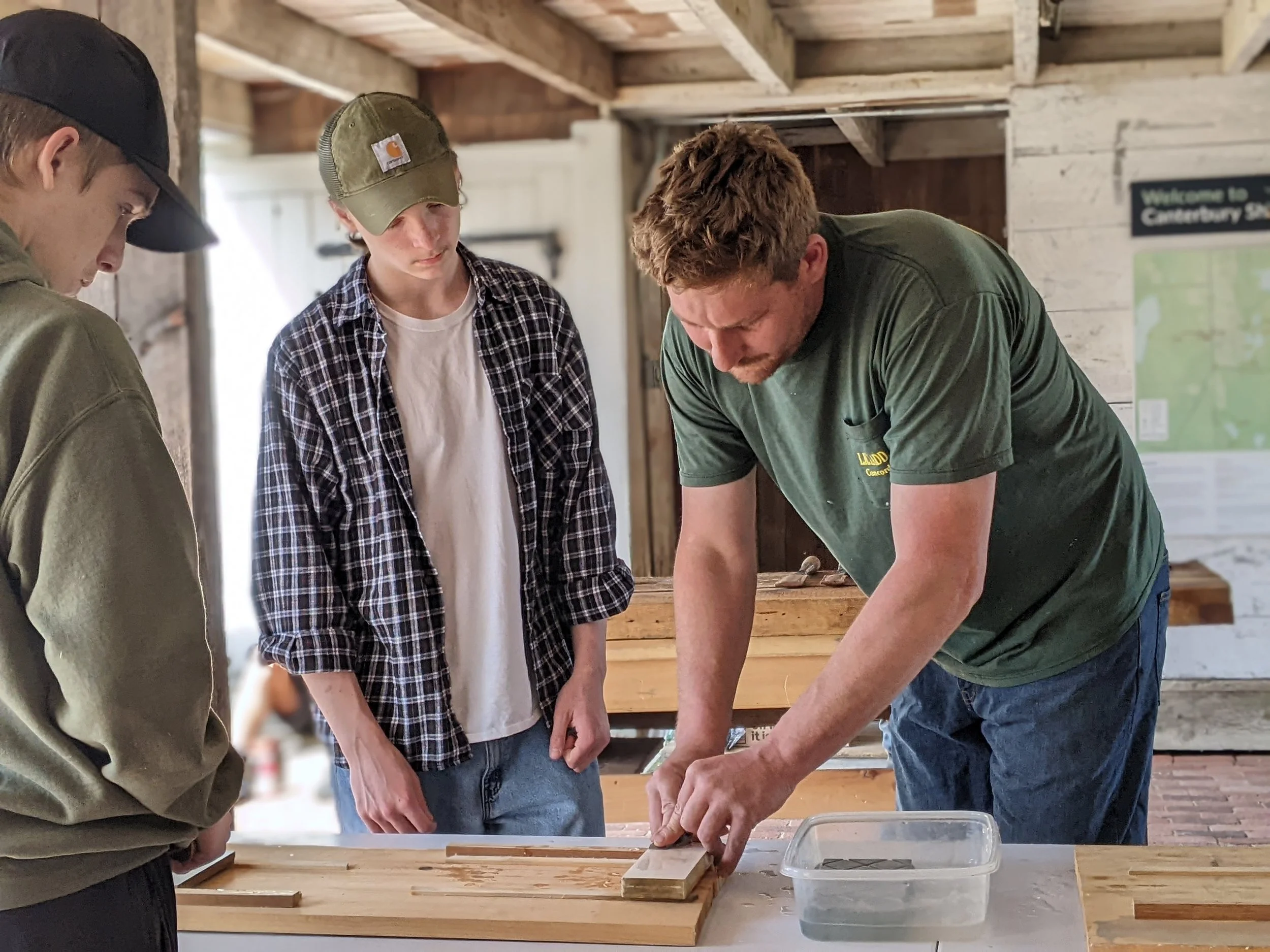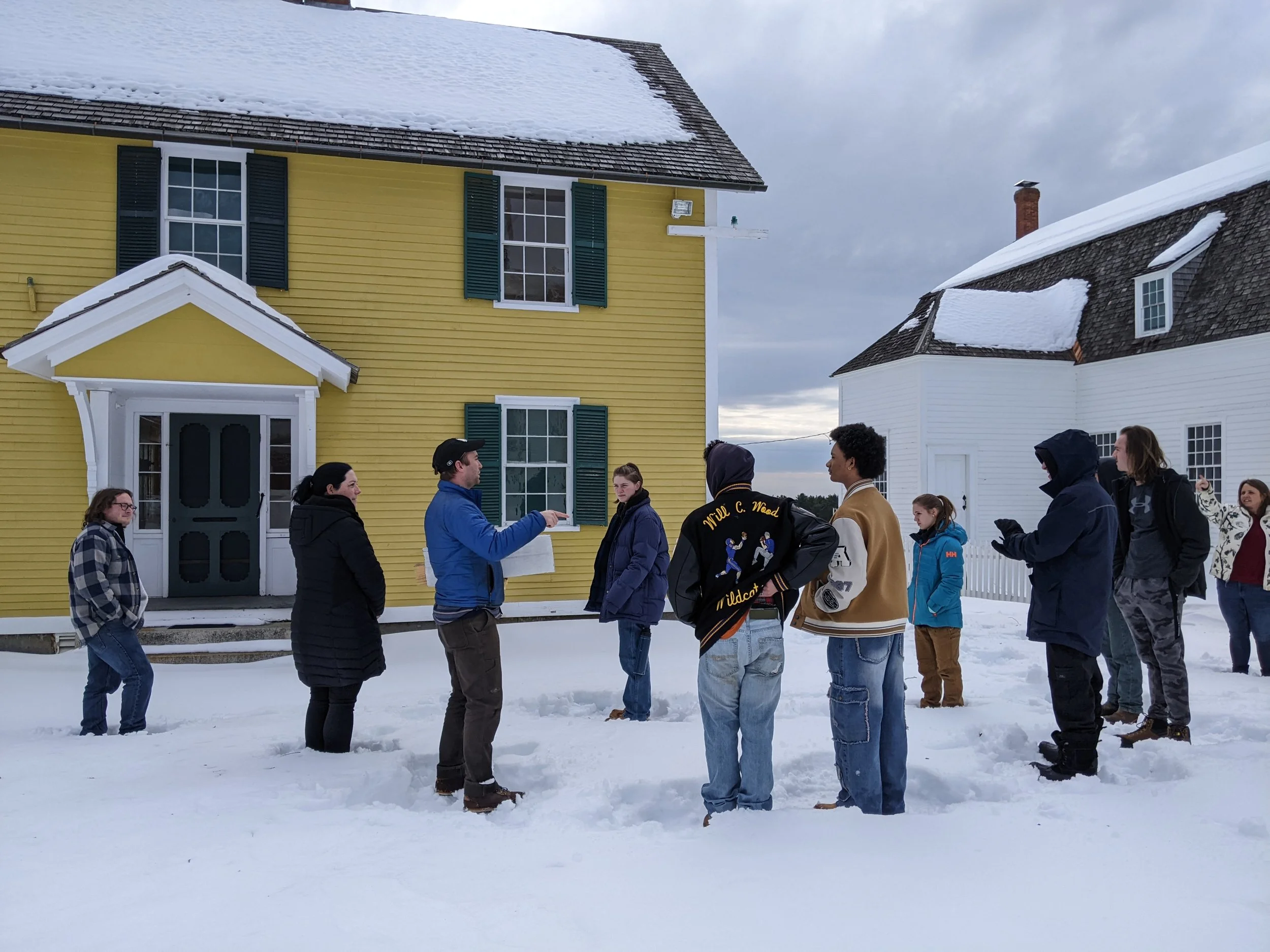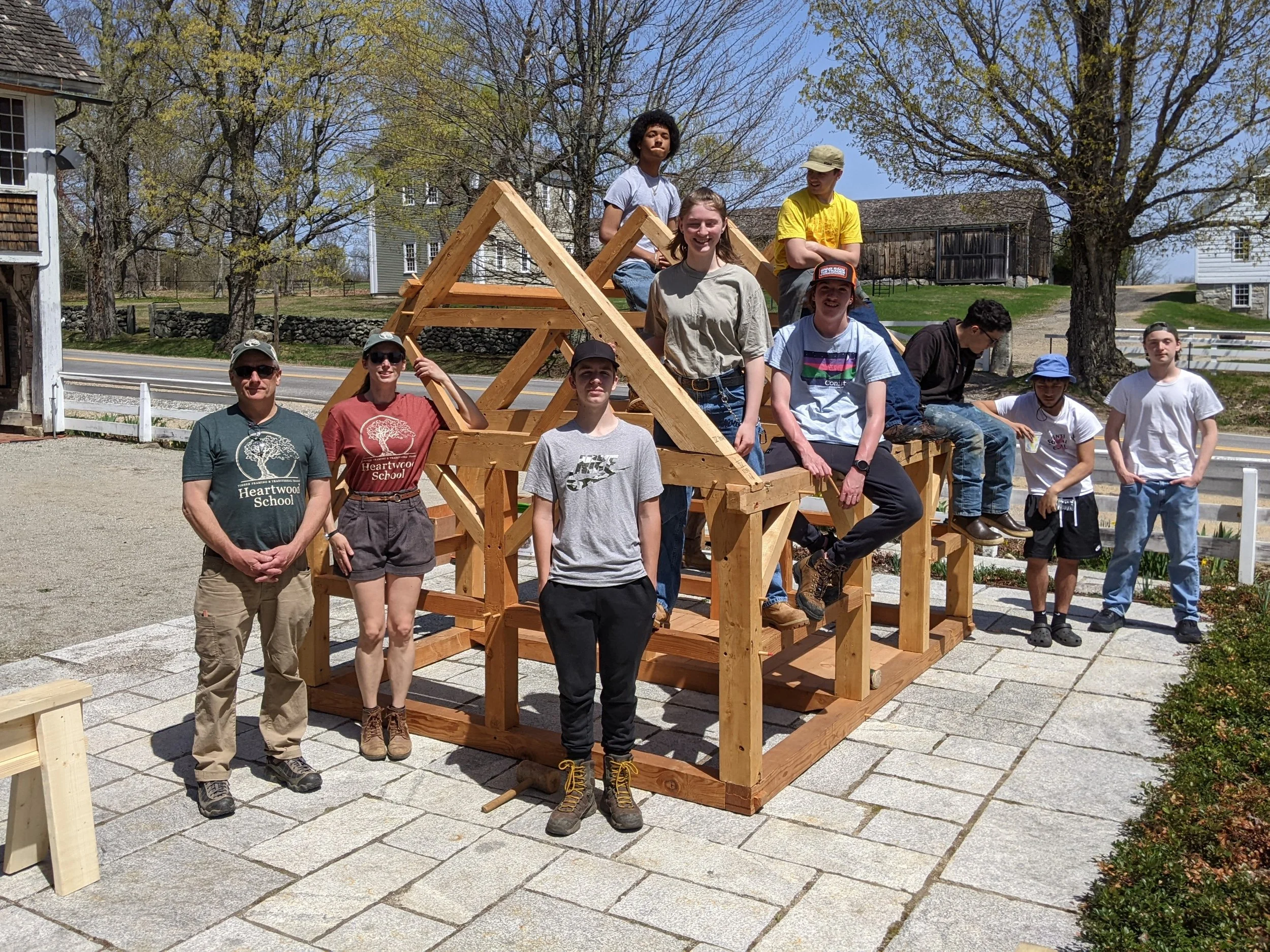Lessons Learned from Career Exploration in the Old Building Trades
Twelve young adults aged 15 to 18 and a team of more than twenty mentors came together this spring for Career Exploration in the Old Building Trades, a program for next generation workers during the February and April school vacation weeks. Together, they built skills, confidence, and community. The program is part of the Preservation Alliance’s multi-pronged Preservation Trades Initiative to address workforce shortages in the trades.
Participants engaged in daily workshops guided by experienced contractors and partners. They learned to sharpen and use woodworking tools, helped repair a historic fence and 200-year old stone wall, assembled a quarter-scale English timber frame barn, practiced window repair and slate roofing skills, forged iron at a blacksmith shop, and explored preservation strategies in some of New Hampshire’s most interesting historic buildings.
Here are seven lessons we learned from the experience.
Young people are interested in the old building trades
Fence repair with Steve Fifield
The 2025 Career Exploration program grew out of our 2024 pilot Mini-Internship, in which three young adults spent one week job shadowing with either Arron Sturgis and the crew of Preservation Timber Framing on the Seacoast, or Arch Weathers of Historic Sashworks in Andover.
This year, twelve young people participated over the course of two weeks. All but one of the eight February week participants asked to come back for the April week, where they were joined by several newcomers. We hadn’t anticipated so many repeat customers, but our mentors rose to the challenge, diving deeper into hands-on projects and real-world preservation experiences.
Most of the group’s activities took place at Canterbury Shaker Village and Sanborn Mills Farm, with some participants visiting Strawbery Banke Museum and other seacoast sites.
Some arrived with relevant experience, like building a shed in a high school construction class, exploring historic museums on field trips, helping a family member do home repairs, working on an old stone wall, studying beehive ovens and barns, or rehabbing an old wooden boat. All brought an open mind. As Noah (16) said in his application, “Super interested and ready to learn!”
Gratitude goes a long way
Sharpening chisels with Oliver Fifield
We approached the career exploration weeks with an “attitude of gratitude.” We all thanked the participants, their families, our mentors and hosts every chance we got. We treated tools with respect. Our preservation partners celebrate each other’s successes and are more likely to collaborate than compete. We wanted to set that tone for the next generation. They jumped right in, in person and in a feedback survey.
Javian (16): “Thank you for the experience. I learned a lot.”
Cian (15): “Oliver and Ian, I enjoyed learning how to sharpen tools and how they are used.”
Joyce (17): “Thank you guys so much, y’all kept thanking us for being interested but the thanks really goes out to you all and all the work you put into it so that we could have an amazing week.”
We’re grateful to our good friend Steve of Steve Booth Photography for capturing so many great images.
Outdoor history museums and historic downtowns make great host sites
New Hampshire’s history museums are great training grounds for next-generation workers, offering a rich educational environment and safe spaces for exploration.
Preservation strategies at Canterbury Shaker Village
Canterbury Shaker Village provided a well-equipped classroom and workshop space. Executive director Erin Hammerstedt, director of interpretation & education Kyle Sandler, and facilities & property manager Todd Muffoletto gave us off-season tours of the village’s historical buildings, including the Meeting House, the Dwelling House, the Garden Barn and the Laundry. We explored the village grounds looking for wavy antique glass in windows of different eras. We learned about the varying ages and conditions of roofs made of slate, wood and asphalt. Erin shared stories of preservation successes and challenges as we walked around, and the young participants keyed into assessing building conditions on their own.
Strawbery Banke Museum hosted a few participants for one or two days. Arron Sturgis, Dan Boyle, and Dave Ewing of Preservation Timber Framing gave a short workshop in stair tread rehab at Penhallow House, and brought them to current and upcoming job sites including the Players’ Ring Theatre and Warner House Museum in Portsmouth. Jodi Black, vice president of preservation, facilities and landscapes, offered cellar-to-attic tours of several Strawbery Banke buildings.
At Sanborn Mills Farm, with founder and executive director Colin Cabot’s encouragement, studios manager Craig Mabie arranged a day of tours showcasing the rehabilitation work of Preservation Award winner Steve Fifield and others. The group worked at the forges in the blacksmithing shop with instructor Garry Kalajian and blacksmith Richard Wright, and watched millwright and sawyer Brian Clough and his son Logan use waterpower to saw a log into lumber in the 1829 sawmill. Head chef Kelly Fahey made us a farm-to-table lunch, teamster Samantha Locke showed us how she shoes a draft horse, and we celebrated the end of the program with a behind-the-scenes climb up into the belfry of the Grange, one of Steve Fifield’s many projects.
Finding common ground
Blacksmithing with Garry Kalajian
Our mentors span the generations, giving this new generation a chance to meet inspiring people at every stage of their careers. Apprentice Victoria Cloyes of The Heartwood School and early-career workers like Hazel Ramirez (Slate & Copper Roofing) and Clark Todd (Olde Window Restorers) demonstrated recently learned skills like assembling a timber frame barn, cutting slate roof shingles, and installing window sash ropes and weights.
Oliver Fifield and Ian Mitchell, mid-career timber framers, gave a workshop in sharpening chisels and using a block plane. They spoke about how they chose this field, how underutilized muscles may hurt when you first start working, and how preservation is more difficult and more satisfying than other construction work. Oliver said the field rewards initiative, coaching new hires to show up on time and bring their own tool belt or hammer.
Santiago Rodriguez of Custom Slate & Copper roofing learned his trade on the job and manages large, specialized roofing jobs. He gave a workshop in cutting and laying slate shingles on a tabletop model. He said a lot of people are uncomfortable with ladders and heights at first, but they get used to it, to which several potential future roofers responded, “I like heights!”
On the other end of the spectrum, our more “seasoned” mentors bring a lifetime of experience – and a sparkle in their eyes when they see young people who seem to “get” the old building trades.
Stone wall repair with Kevin Fife
Kevin Fife of Twin Elms Landscape shared words of wisdom as he taught the group how to dismantle a wall stone by stone and put it back together, better than before. Kevin represented New Hampshire at the 1999 Smithsonian Folklife Festival and specializes in the traditional art of dry stack stone walls. “I felt a lot of gratitude to help the kids,” he said later. “That made me really happy.”
Steve Fifield and Sue Hardt came out of retirement to work together. Steve has a long history of teaching next generation workers, and Sue is the first woman to graduate from Wentworth Institute of Technology, in 1974. Their young apprentice, Evan Loreman, joined in on the activities. Ian Blackman, recently retired, and Dennis Moore of Moore Construction, shared their experiences building and repairing strong stone foundations for homes and barns.
As Windham Woods School chaperone and director of experiential learning Jeremy Robbins said, “The mentors told stories that seemed like non sequiturs, but they were passing on life wisdom woven into the hands-on work.”
Education takes many forms
Mentors and students found common ground with stories of their own academic challenges, learning differences, and the joys of putting geometry and algebra into practice. We talked about the benefits of on-the-job training, degree programs at schools like North Bennet Street School in Boston, workshops at Sanborn Mills Farm, and classes at community colleges like NHTI.
Neil Godden, executive director of The Heartwood School, guided the group in assembling a quarter-size timber frame English barn by Tom Musco. Students at Heartwood learn to design and build timber frame structures, with courses ranging from one day to several weeks. Neil emphasized Heartwood’s core values of “connecting minds, eyes, and hands in seamless harmony to craft beautiful objects, large and small, with which to enrich lives and communities.”
What do our next-generation workers want most?
Real work! In our feedback survey, the #1 request from participants was for more hands-on activities. They asked for longer days for more work, and more time actually engaging in the trades. All said they enjoyed the program and want to learn more. When asked whether they’d consider a career in the old building trades, all were at least a “maybe,” and several said, yes, I can’t wait to graduate from high school and get to work!
Alden Witham of Olde Window Restorers shared his work philosophy including keeping window restoration accessible to homeowners, and the ecological benefits of repair vs. replacement. He showed us how to work mindfully and efficiently to control costs and prevent injury. “I think he’s the best kind of boss you can have,” Owyn (18) said. “He treats workers well.”
Niko (16) especially liked the preservation strategies tour with Mae Williams of Unlocking History and Andrew Cushing (former community preservation services manager, now on leave from the Preservation Alliance). Silas (17) shared, “It was great because I didn't know those jobs existed and I wouldn't have learned anything about them.” Taliah (17) wrote, “I enjoy the idea that people can still create cool structures using old building techniques. I hope to learn a lot about this form of work.”
Participants asked for future workshops in plastering, stained glass, electrical, energy and efficiency, architectural design and planning, decorative finishes, interior design, and deconstruction.
Hospitality works wonders
Betty Fifield knows well that good food means good energy. Her made-from-scratch Shaker squash rolls, muffins, and cookies are legendary. Betty provided healthy breakfasts and snacks, baking for us almost daily in her commercial kitchen. Oziel (15) was a big fan. When signing up for his second week, he asked, “Will Betty make muffins again?”
Next steps
As we celebrated the end of the Spring 2025 program, some next-generation workers asked, When can we do this again? How can I learn more?
In the belfry at Sanborn Mills Farm (photo Craig Mabie)
Our preservation trades initiative continues with enriching summer programming, support for other organizations’ endeavors, and summer internships. There is a lot of demand for skilled workers in these trades, and a high rate of job satisfaction (96% according to Understanding and Advancing the Preservation Trades, a report by University of New Hampshire Cooperative Extension).
Will some of this year’s Career Exploration participants become the next generation to work in preservation? Time will tell. Either way, we’re sure they now have a deeper understanding of the old building trades and the people who want to pass on their skills.
Learn more about our Preservation Trades Initiative here.








